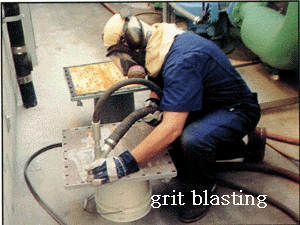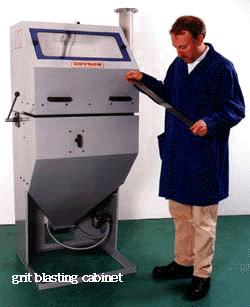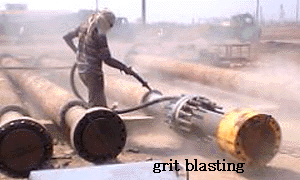We offer a grit blasting service to prepare the metal surface before coating or painting. This is carried out in a blast room, (size 3x4mtrs long). Using grade 7 and 12 grit.
We also have the ability to strip and degrease items before a primer or top coat is applied. We also mask items to individual specifications if required.
Abrasive blasting media
1. aluminum oxide
As an angular, durable blasting abrasive, aluminum oxide (or aluminium oxide) can be recycled many times. It is the most
widely used abrasive grain in sand blast finishing and surface preparation because of its cost, longevity and hardness.
Harder than other commonly used blasting materials, aluminum oxide grit powder penetrates and cuts even the hardest
metals and sintered carbide.
Approximately 50% lighter than metallic media, aluminum oxide abrasive grain has twice as many particles per pound.
The fast-cutting action minimizes damage to thin materials by eliminating surface stresses caused by heavier, slower
cutting media.
Aluminum oxide grit powder has a wide variety of applications, from cleaning engine heads, valves, pistons and turbine
blades in the aircraft industry to lettering in monument and marker inscriptions. It is also commonly used for matte
finishing, as well as cleaning and preparing parts for metallizing, plating and welding. Aluminum oxide abrasive grain
is the best choice for an abrasive sand blasting and polishing grain as well as for preparing a surface for painting.
As a premier aluminum oxide abrasive grain supplier, Kramer Industries recommends using virgin, brown aluminum oxide for
optimal performance versus reprocessed or remanufactured product. Virgin, brown aluminum oxide contains less than 1.5%
free silica and is therefore safer to use than sand. The grit size is consistent and cuts much faster than sand, leaving
a smoother surface. Generally, the larger the grit size, the faster aluminum oxide will cut.
2. aluminum oxide
White aluminum oxide (or white aluminium oxide) grit is a 99.5% ultra pure grade of blasting media. White aluminum oxide
is increasingly being used in critical, high-performance microdermabrasion equipment. The purity of this media along
with the variety of grit sizes available make it ideal for both traditional microdermabrasion processes as well as
high-quality exfoliating creams.
White aluminum oxide is an extremely sharp, long-lasting blasting abrasive that can be recycled many times after the
initial media blasting. It is the most widely used abrasive in blast finishing and surface preparation because of its cost,
longevity and hardness. Harder than other commonly used blasting materials, white aluminum oxide grains penetrate and
cut even the hardest metals and sintered carbide.
Approximately 50% lighter than metallic media, white aluminum oxide has twice as many particles per pound. The fast-cutting
action minimizes damage to thin materials by eliminating surface stresses caused by heavier, slower-cutting media
blasting grits.
White aluminum oxide blasting media has a wide variety of applications, including cleaning engine heads, valves, pistons
and turbine blades in the aircraft and automotive industries. White aluminum oxide is also an excellent choice for
preparing a hard surface for painting.
White aluminum oxide contains less than 0.2% free silica and is therefore safer to use than sand. The grit size is
consistent and cuts much faster than other sand blasting media, leaving a smoother surface.
3. corn cob
Corn cob blasting grit is a safe blasting media for delicate parts in addition to use as the preferred blasting grit for
log homes and other wood surfaces. Corn cob grit abrasive will remove surface contamination, debris and coatings with
little to no impact on the substrate.
Corn cob is a biodegradable, organic blasting media that is obtained from the hard woody ring of the cob. It is resistant
to break down and can be re-used multiple times in the blasting process. Corn cob is available in a variety of grit sizes
and presents no health or environmental hazards. Virtually dust-free blasting with no sparking leaves a clean and dry
surface.
4.crushed glass grit
Crushed glass grit is manufactured from 100% recycled bottle glass. This glass grit delivers superior performance relative
to mineral/slag abrasives. Crushed glass grit contains no free silica, is non-toxic and inert and contains no heavy
metals typically found in coal and copper slags.
The angular particles in crushed glass grit allow for aggressive surface profiling and removal of coatings such as epoxy,
paint, alkyds, vinyl, polyurea, coal tar and elastomers. Glass grit is lighter weight than many slags, allowing for
increased consumption efficiency and production time ? up to 30-50% less glass grit used. Crushed glass grit delivers
very low particle embedment, which produces a whiter, cleaner finish. Similar to many slags, crushed glass grit has a
hardness of 5.0 ? 6.0 on the Moh’s Hardness Scale.
5.glass beads
Glass beads are manufactured from lead-free, soda lime-type glass, containing no free silica that is made into preformed
ball shapes. Glass beads produce a much smoother and brighter finish than angular abrasives. Glass beads can be recycled
approximately 30 times. Chemically inert and environmentally friendly, glass beads are an acceptable method of metal
cleaning or surface finishing when properly controlled.
Glass bead blasting produces a clean, bright, satin finish, without dimensional change of the parts. Available in a wide
range of sizes, glass beads are primarily used in blasting cabinets for honing, polishing, peening, blending, finishing,
removing light burrs and cleaning most light foreign matter. For delicate thin-walled parts and thin welds, peening
with glass bead abrasive material provides the right balance of stress relief without over-stressing and causing damage.
Consider the size of perforations or holes through which the glass beads must pass when screen separating parts from
media after use.
6.pumicee
Pumice is a natural mineral - volcanic ash formed by the solidification of lava that is permeated with gas bubbles.
Pumice powder is used chiefly as an abrasive and is among the softest of all media. Use pumice powder for less aggressive
operations where the protection of the surface is of supreme importance. Pumice is the best media choice for tumbling
plastics.
7.silicon carbide grit
Silicon carbide is the hardest blasting media available. High-quality silicon carbide media is manufactured to a blocky
grain shape that splinters. The resulting silicon carbide abrasives have sharp edges for blasting. Silicon carbide has
a very fast cutting speed and can be recycled and reused many more times than either sand or aluminum oxide. The hardness
of silicon carbide allows for much shorter blast times relative to softer blast media.
Silicon carbide grit is the ideal media for use on glass and stone in both suction or siphon and direct pressure blast
systems. The ability to be recycled multiple times results in a cost-effective silicon carbide grit blast media with
optimal etching results.
Since silicon carbide grit is harder than aluminum oxide, it can be used efficiently for glass engraving and stone etching.
Silicon carbide grit blast media has no free silica, does not generate static electricity and is manufactured to contain
minimal magnetic content.
8.steel grit
Steel grit blasting is ideal for aggressive cleaning applications. Steel grit will quickly strip many types of surface
contaminants from steel and other foundry metals. Steel grit is softer than aluminum oxide and does not fracture as easily,
making it ideal for aircraft and aero-space applications. The angular nature of steel grit produces an etched surface
on metal for superior adhesion of paint, epoxy, enamel, rubber and other coatings.
Different chemistries will lead to different operating results, depending on the size and hardness of the grit.
Since Kramer is a primary steel grit supplier, multiple chemistries of steel grit are available. Steel grit that is
formulated as a softer (40-50 HRC) metal will round off rapidly, making it ideal for quick stripping of oxides and
cleaning of molds. Harder steel grit (55-65 HRC) will maintain the angular nature of the grit to provide continuous
cutting action.
9. seel shot
Steel shot blasting is the most widely used process for cleaning, stripping and improving a metal surface. The grade or
size of steel shot will determine the ultimate finish achieved on the surface of the metal. The round ball shape of
the steel shot produces a clean, smooth and polished surface through a peening action created by the acceleration
of the shot. In a peening application, steel shot is also used to impart compressive strength to torque or load bearing
metal parts such as crankshafts, engine turbine blades and heavy-duty springs.
Smaller steel shot will result in a smoother and more polished surface. Larger shot will clean more aggressively but
produce a rougher surface. Both air powered and wheel blast systems can be used to accelerate the steel shot onto the
surface of the part. Due to the hardness and density of steel shot, it can be recycled as much as 3000 times before
replacement. Since steel shot does not use an abrasive process, a minimal amount of dust is created in the blasting
process.
|


